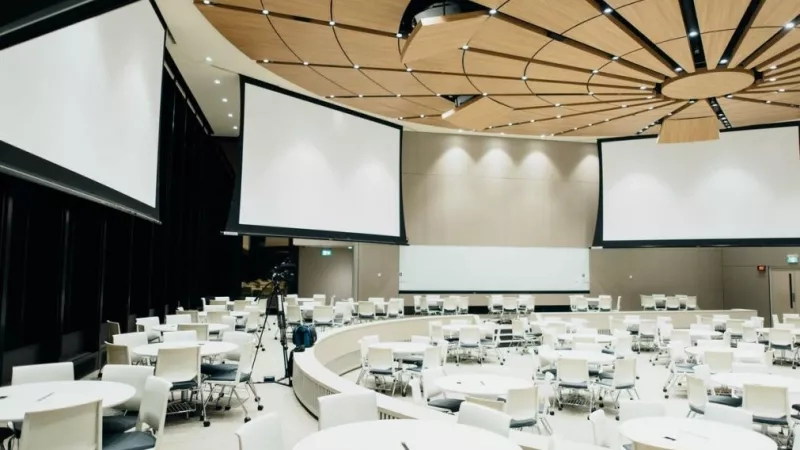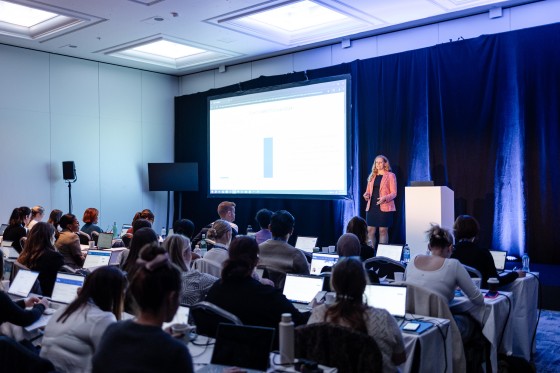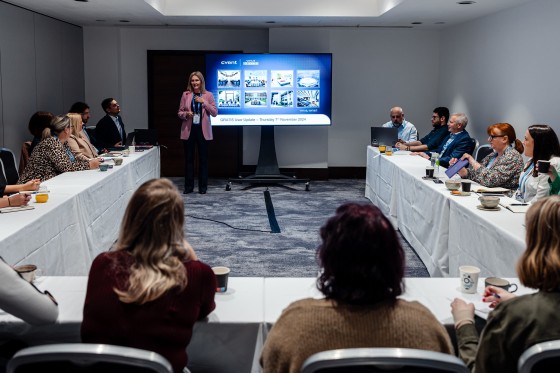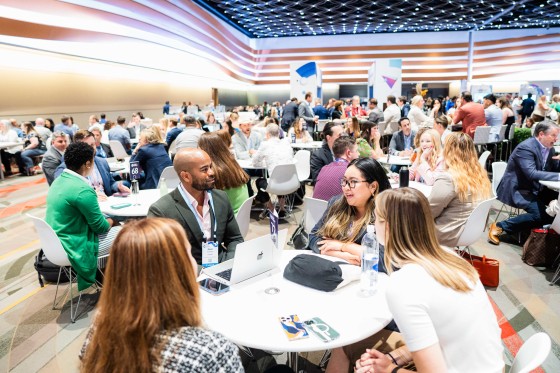When it comes to event planning, the right seating can make all the difference. Ideal seating styles ensure comfort, enhance your event’s aesthetic, and facilitate a positive experience for all. We’re going to take a closer look at different event seating styles and how to choose the right style based on your event specifications, venue layout, and intended goals.
While considering the possibilities of the many seating styles, it’s worth keeping in mind that 87% of meetings were conducted in person in 2023, which means 87% of the time, event seating was probably a part of the equation.
With so many event seating styles to consider, it can easily become overwhelming as you look at your event space and try to figure out which layout looks and feels best while optimizing the total space available. While there are many styles of seating styles for conferences, meetings, banquets, and other event types, there are merits to each seating style depending on logistics and your agenda.
Let’s parse through the various types of seating available, including seating styles that are appropriate and practical for conferences and meetings and those that are more suitable for networking and social events.
1. Conference style seating
Conference style seating is ideal for large events where attendees need to focus on a central speaker or presentation. Utilizing event design software, planners can ensure optimal visibility and accessibility for participants. This layout is perfect for corporate event planning and conference networking, allowing for clear sightlines and ease of movement.
2. Meeting style seating
Meeting style seating is designed for smaller, more intimate gatherings. Event seating software can help arrange tables and chairs to foster interaction and collaboration. This style is an excellent option for events that emphasize engagement and discussion.
3. Boardroom style seating
Boardroom style seating is a staple in corporate event planning, offering a professional setup for high-level meetings and discussions. Incorporating event decoration ideas can enhance the ambiance, making the space inviting yet functional for serious and meaningful discussions.
4. Classroom style seating
Classroom style seating mimics a traditional educational setting, making it ideal for workshops and training sessions. This layout can be easily visualized with event design software and adjusted with event seating software to ensure comfort and focus for attendees.
5. Banquet style seating
Banquet style seating is perfect for dining events and large celebrations, often using large round tables lain out with a set amount of space between them. This layout facilitates social interaction and can be customized with event decoration ideas to fit your themes and venue.
6. Cabaret style seating
Cabaret style seating combines the best of banquet and conference styles, offering a mix of round tables and open space. This setup is perfect for interactive event ideas that lean into interactions with the audience and allows for both dining and presentations.
7. Chevron style seating
Chevron style seating offers an angled arrangement that maximizes space and visibility. It's great for events requiring a combination of presentations and interactive sessions and can be tailored using event seating software for an optimal layout.
8. King’s table style seating
King’s table style seating features long, rectangular tables, ideal for creating a communal atmosphere at dinners or receptions. This style requires a large, rectangular space, so using event design software to help you visualize the setup will help ensure it fits within the confines of your venue.
9. Auditorium style seating
Auditorium style seating is designed for large audiences, providing clear sightlines to a central stage or speaker. Rows of seating are typically laid out in a way that allows everyone to be facing one focal point in the room, much like a theater.
10. Horseshoe style seating
Horseshoe style seating, also known as U-shaped seating, encourages interaction and discussion. This layout is good for both presentations and collaborative sessions, making it a versatile option for a wide range of events and small group gatherings.
11. Cocktail style seating
Cocktail style seating focuses on mingling and social interaction, with high tables and minimal seats. This style is perfect for networking events and can be enhanced with creative event décor ideas to foster an aesthetically pleasing atmosphere that encourages engagement.
As the name implies, cocktail style seating is often best for gatherings where light food and drinks will be available, so you’ll likely need to consider where a bar or food service area can be set up alongside your tables and seating.
12. Family style seating
Family style seating encourages communal dining and interaction, with long tables shared by guests. This layout is great for creating a warm, inclusive environment and can be tailored to fit event themes and specific venue specifications using event design software.
13. Pod style seating
Pod style seating is great for small group collaboration, clustering small groups of people into clear segments. This can look like chairs placed in circles throughout the room, or there might be tables included as well to allow for desktop hands-on collaboration.
14. Stadium style seating
Stadium style seating, as the name suggests, is what you’d see in a sports or entertainment stadium with tiered rows that allow everyone to see the stage or focal point below. This seating style isn’t practical for every venue, but it might be an option if you use risers or are working with an event space that’s set up with tiers.
15. Semi-circle style seating
Semi-circle style seating arranges chairs in a half circle facing a stage or presenter. This allows for a more intimate and inclusive environment, allowing a presenter or leader to see and communicate with everyone in the room with ease.
16. Cafe style seating
Cafe style seating uses small tables and chairs, similar to what you’d see in a coffee shop, to allow for one-on-one conversations. This setup is perfect for events like speed networking or for creating opportunities for attendees to meet informally with their peers.
17. Hollow square style seating
Similar to horseshoe style seating, hollow square seating places tables and chairs in a square pattern with the center left empty—connect the “u” into a complete square. This is a great way to create discuss and collaboration but is best suited to meetings and events where there will be no presentation, as attendees won’t be able to face a presenter with ease.
18. Free-form style seating
If you’re going for a relaxed, informal setup, free-form style seating is a fun way to gather attendees. Think bean bag chairs, cushions, and other soft seating scattered throughout the room, allowing attendees to choose any seat they like and get comfortable. Of course, this might not be the best seating style if you need your attendees to pay close attention, as they might be a bit too relaxed!
10 factors to consider when selecting an event seating style
As you work through your event checklist, you must remember to consider your event seating styles for each session, activity, workshop, etc. Choosing the best seating arrangement is an essential component for the development and creation of a comfortable, functional, and engaging event environment. Let’s look at key factors to keep in mind as you weigh event seating style options.
1. Event type
The type of event you’re planning plays a major role in determining ideal seating arrangements. It almost goes without saying that a conference requires different seating than a cocktail party.
2. Venue layout
The dimensions and layout of different venue types will help determine the appropriate seating style for any event. Not all layouts will fit comfortably within a venue’s limitations.
Working with a venue that uses event design software can help you explore how different seating styles will fit into the space and ensure there's enough room for comfortable movement and accessibility.
3. Audience
Consider the number of attendees and their individual needs. Large audiences might benefit from auditorium or conference style seating, whereas more intimate gatherings might be better served by boardroom or horseshoe style arrangements.
4. Event objectives
Your goals for the event will influence your choice of seating. For instance, networking events may benefit from cocktail style seating to encourage mingling, while training sessions might require classroom or pod style seating for improved focus, learning, and collaboration.
5. Comfort and accessibility
Ensure all seating arrangements are comfortable and accessible for all attendees. This includes considering wheelchair access, ample space for those with physical disabilities to maneuver, specific needs for those with audio or visual impairments, and even the comfort of those who require a little extra comfort, such as older attendees or those who are pregnant. It’s important for everyone to feel equally welcome and comfortable, no matter their individual needs.
6. Interactive elements
If your event includes interactive activities, such as group discussions or workshops, choose a seating style that facilitates interaction. Cabaret or horseshoe styles could be wise choices for fostering engagement and collaboration.
7. Aesthetics
Selection of seating style should fit well into the space you’re working with, both in terms of space available and the look of the space once seats have been arranged. If you plan to incorporate event decoration ideas into your layout, be sure your seating plan can accommodate and enhance the visual appeal and create an overall cohesive and pleasing appearance.
8. Budgeting
Keep in mind your budget and the resources allocated for your event. Some seating styles may require more furniture or specific types of chairs and tables, and this can mean a notable increase in cost. Be sure that your choices align with your financial and logistical constraints, and where possible, work with your venue to use any furnishings that are included with your contract.
9. Flexibility
Choose a seating style that can be easily adjusted if needed. Events can sometimes require last-minute changes, so having a flexible seating plan can save time and stress.
10. Logistics
Think about how the seating arrangement will affect the flow of the event. You’ll want to ensure attendees can move easily between different areas, such as stages, dining areas, and designated networking areas. You’ll also need to consider how you’re getting furniture in and out of spaces and how much time you’ll have to set up and tear down your seating arrangements.
Frequently asked questions
How do you arrange tables for an event?
When arranging tables for an event, consider the event type, attendance numbers, venue size, and your event goals to determine your seating needs. Then, select a seating style that suits each of those criteria. Keep in mind guest comfort, accessibility, and logistical concerns so you can reduce friction as guests shift around during the event.
What is the proper seating arrangement?
The proper seating arrangement depends on several factors, including the event type, objectives, audience size, venue layout, and the desired interaction level among attendees. While conference or auditorium style seating allow for a clear view of a stage if you have a speaker or presentation, you might prefer boardroom or horseshoe style seating for smaller meetings where collaboration is the goal.
Workshops and training sessions benefit from classroom or pod style seating, as these options provide a structured environment conducive to learning where attendees can see a focal point in the room to watch a presentation but can also work in small groups.
Dining events typically benefit from banquet or family style seating designed to create a communal experience. On the other hand, cocktail style seating encourages mingling and socializing with light bites, which is great for networking and welcome activities where guests are encouraged to mingle.
How do you create a seating chart for an event?
To create a seating chart for an event, you must consider your event type and goals, the number of guests, your venue layout and dimensions, and possible seating styles. Make use of event design software to map out potential seating styles and configurations, and once you’ve chosen your seating style and layout, your can begin mapping where you want each attendee to sit.
As you create your seating chart, consider attendee comfort, accessibility needs, and how you want attendees to interact with one another. Grouping people who need to interact closely makes sense, but also consider whether you want to spread anyone out to encourage mingling.










